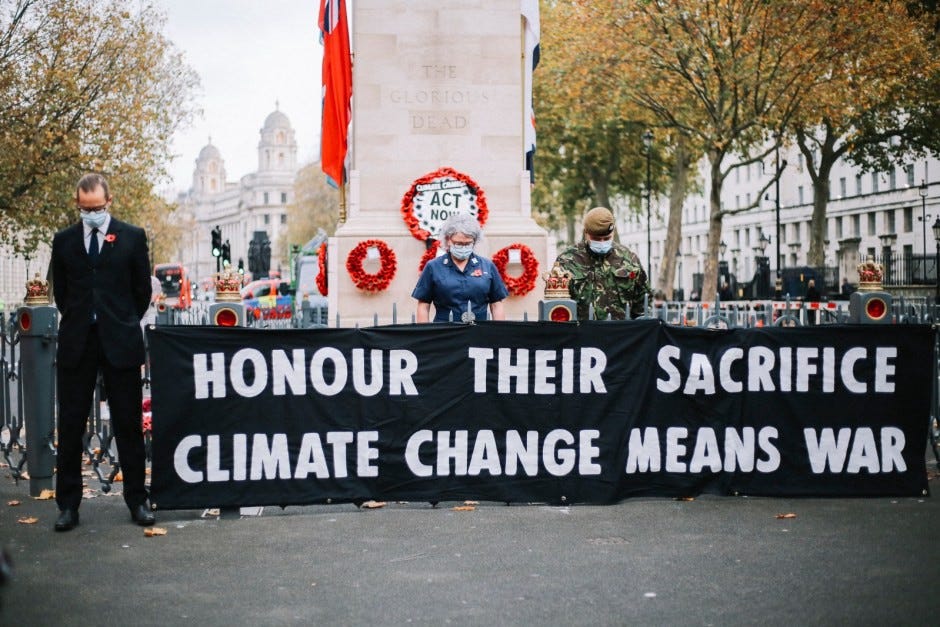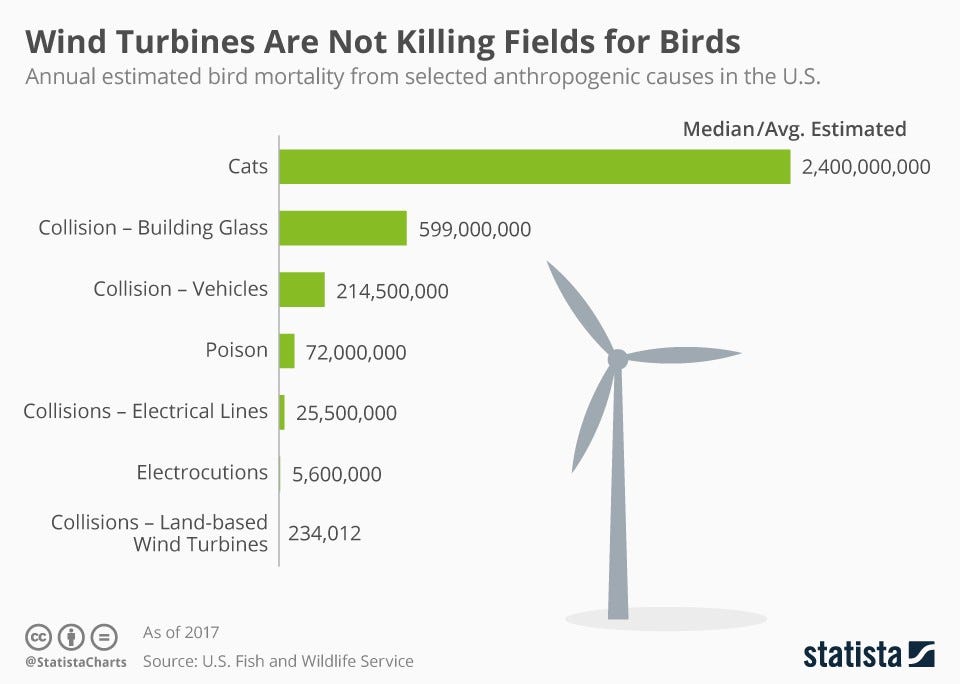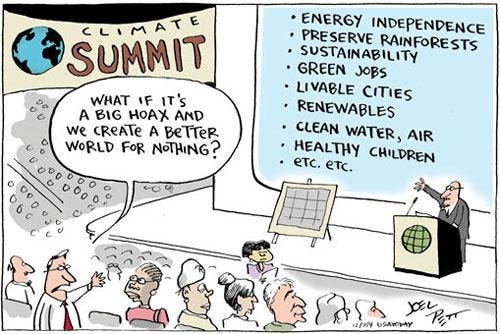Why the climate action narrative needs to change
We call for the climate conversation to shift away from its focus around the eco-warrior and instead frame climate action in a way that is relatable to all.
Hello grumpy optimists. 👋
Climate action is in the best interest of everyone on earth (well nearly everyone - looking at your fossil fuel execs) but all over the world we struggle to turn ambition into climate action. We thought we’d put our thoughts together on how we solve the framing issue. Let us know what you think.
(this post was first published in Feb 2021).
🖼 Framing is key
The framing of a topic is important; it has the power to distort the truth and change what people believe in. It is often stories and narratives that win elections, lure us to purchase a product, or lead us to believe in something. This is evident in politics, with the Brexit slogan calling for Brits to ‘take back control’ stoking up a story which marvelled a nation’s resurrection, as it reclaimed its identity from the bureaucrats in Europe. Or Trump’s infamous ‘MAGA,’ resonating with folks in middle-America who have been left behind over the last 40 years. It’s also evident in business, with entrepreneurs like Elon Musk building an almost cult-like following through the narrative he has built around himself. Building a narrative is not easy, but when they stick they are scarily powerful.
Changing minds, building public will, and creating the political and economic engagement on an issue like climate change requires language, stories, and a narrative which people can relate to. Indeed, the ideas are primary, but it is the language which carries, builds, and executes those ideas. So then, what is the framing of climate action, and why hasn’t it worked?
What even is 1.5 degrees?
The predominant stories we tell ourselves about the climate crisis are framed around a handful of figures, which while devastating when broken down, are on the surface, meaningless. 1.5 degrees of warming, net-zero carbon by 2050. A few notches on the thermostat doesn’t sound like anything to be worried about, while 2050 makes it sound like we’ve got time to put out feet up before the hard work of climate action need begin. For over 40 years, scientists, politicians, and activists have continued to frame climate change, biodiversity loss, and ecological breakdown around arbitrary facts which fall on deaf ears. They don’t engage us because they don’t tell a story.
On the rare occasion that climate action does penetrate its way into the media, more often than not we see it framed as those Greta Thunberg kids wanting time off school or something that eco-warrior tree huggers do. You know the type, those who preach about recycling, only wear second-hand clothing and think eating meat should be enlisted as the eighth deadly sin. This rhetoric for climate action might be seen as positive to some, but it’s problematic and certainly won’t get the backing of your Barrys and your Susans (no offence to anyone called Barry or Susan).
But what’s the problem? 🤔
There are two issues with the eco-warrior narrative and how it shapes climate action and climate change more widely.
Firstly, it (re)produces the long-standing romanticisation of the environmental agenda as a passion-project for those who are willing to carry the mantle, while excusing the rest of us to bury our heads in the sand.
Second, and more importantly, the term eco-warrior has been hijacked by the likes of Extinction Rebellion, creating a framing issue, where it looks as if to care about the environment you have to be a lunatic, dancing in the street, blocking everyday people from getting to work or hijacking the Cenotaph on Remembrance Day. Neither of us would deny that civil disobedience has a role to play, but it must be one weapon in a wider artillery of climate action.
Contrary to their aim, non-peaceful protests and demonstrations often antagonize and irritate the very people who the climate movement desperately needs to engage. Rather than reinforcing the disdain and mockery with which the right-wing media have plagued climate activism for decades - see only the latest thoughts on the F1 protests at Silverstone in 2022.
A new narrative needs to be written if we are to create the necessary economic and political change. A narrative that can resonate with everyone, not just the ‘hippies’ or ‘lefty loonies’.
What needs to change and how?
It’s worth asking then: is there a flaw in the framing of climate action? Is it time to create new stories and open up climate action to all? We believe the answer to both is yes. But what does a new narrative and framing look like?
Well, that’s dependent on who you are trying to engage and how you can frame climate action in a way that makes sense to them. While climate action can only succeed with a collective and shared will, engagement begins with the individual. This means framing the importance of climate action in the context of issues which we care most about and using familiar words, stories, and metaphors to communicate this. If survival in itself is not attractive enough, we have to sell climate action as a means of securing livelihoods, creating masses of jobs, and protecting the health of our communities. We must create a story for the future which every individual can relate to and work towards.
🏥 Health
One example is to build the climate conversation around health. If the pandemic has taught us anything, it’s that our existence is fragile and that for the most part, we listen and take note when we’re told this is at stake. Fear of contracting the virus has led us to shield, distance, and in large part, lockdown our lives. But rarely do we see climate change framed as such a direct threat. On the chance occasion that we do, inundated cities, wiped-out rainforests or dry dustbowls tend to evoke a sense of apocalyptic inevitability, but one that is far into the future.
In reality, the impact which climate change is having upon our health is on the whole, far less visible. And it’s happening now. So why aren’t we putting our face-masks on for this too?
For this, we can look at the role of messaging. Traditionally, the communication around the environment has been centred on climate change and the importance to shift away from fossil fuels, however, the Sierra Club Ready For 100 campaign has chosen to focus on the importance of clean and healthy air, a problem that affects 90% of the world.
By framing the shift towards renewable energy around healthy air and water, not climate change, the messaging stuck. People connected with the importance of clean air and water because they could see the positive health benefits it would have upon their everyday lives. Literally, the air that they breathe and the water that they drink. Vague narratives about the future of the planet’s health do very little to engage the masses; we have to contextualise climate action within our everyday experiences, and framing it as a plus for our health is a great way to do this.
🔐 Security
Okay, but what about those who don’t care about our health? And we’ve seen you, with your masks hanging off your ears. Climate action can also be framed in the context of national and energy security. This is made even more important in the context of the Russian invasion of Ukraine and the disruption of oil supplies.
For this, let’s look at the environmentally damaging and unprofitable fracking industry. (1) Fracking is extremely popular in the US, not only with rich landowners and Americans who have seen jobs flow into often poor, rural or ex-industrial areas but also with the Government. It’s easy to see why. Fracking has single-handedly allowed the US to become energy independent for the first time in over 60 years, free from relying on Middle East imports. A major landmark for the world’s largest economy, whose foreign and domestic policy for decades have been centred around a series of dirty oil wars and profiteering.
The narrative of fracking as patriotic and supporting US security and wealth creation for American citizens is powerful, and it has worked. So then, why have renewables not been able to use this same message? Why has Trump’s assault on wind turbines as bird-killing carbon-spewing machines worked? Looks to us like it’s cats that the birds should keep an eye on.
With no small thanks to the billions of dollars behind fossil fuel PR, it’s the messaging that has stuck. The environmental impacts of fracking have scarcely been considered, in part because it’s hard to see the immediate damage it causes.
But it’s also the simple narrative and metaphors which Trump and others use. You can easily imagine birds like the American Eagle flying into a wind turbine, but imagining what goes on below the surface of the fracking industry isn’t quite as easy.
We know that within a matter of years, a widespread transition to renewables can produce the same energy security, at a fraction of the cost to both the taxpayer and the environment. It can also become part of a broader Green New Deal, which aims to use climate action as a lever to create millions of jobs in clean energy sectors, and support those who will be hardest hit by the transition away from fossil fuels with a series of stimulus packages. Let’s learn from the fracking campaign, and carve out a new story for renewables.
💰 Economy
Perhaps most important of all. To shift the narrative on climate action, it has to work for the economy. The environment and the economy have long been framed as the two contenders in a zero-sum game; we’re often made to think that it’s a case of one or the other. And when a strong stance on the environment is pitted against our immediate livelihood — our jobs, incomes, and our financial security — it’s easy to understand why few of us have time or energy to care about saving the polar bears. Growth, jobs, development first; worry about the impending environmental catastrophe later.
Nowhere is the story told better than at a macro-level. For decades the drive for climate action on the global stage has stuttered at best, with the likes of the Paris Agreement and the UK’s climate change act in 2008 showing signs of progress, but doing little to limit our impact on the planet. Leaders are unwilling to honour binding Treaties which aim to dramatically reduce our dependence on fossil fuels in fear that it will compromise GDP. Our economy’s constant thirst for growth has taken priority over the planet.
But this is far from the truth. Though it may not satisfy eye-wateringly high GDP figures, climate action is an extremely important part of building a fairer and more sustainable economy. As part of a Green New Deal, we need to (re)write the narrative so that we see how climate action and economic prosperity can exist together, and even mutually support one another. The shift away from fossil fuels provides a unique opportunity to actually ‘build back better’ — we can centre climate action and our transition away from fossil fuels at the heart of a wider transformation which creates fulfilling jobs, stronger welfare systems, and more resilient, supportive communities. GDP is not the only way to measure growth.
The environment and the economy do not have to be enemies. Investing in renewables is actually a positive, with every dollar invested having a multiplier effect of six. Seems like smart business to us? The meme below sums it up perfectly.
We’re starting to see this shift at a business level, where companies have begun to respond to consumers’ demand for more eco-friendly products, and less environmentally suffocating packaging. The likes of Brewdog, Microsoft, as well as Exeter-based Two Drifters Rum, are all examples that show business and climate action are not mutually exclusive.
In short, investing in climate action and renewable energy should not be framed as a hindrance to the economy. Much of this includes the need to shift away from seeing the government as having to balance the books and treating national finances in the same way as a household does. You can read more on that here — we just don’t have time in this post.
Conclusion
So, what do all these examples show? They show that with the right framing we can make even climate change deniers support policies on climate action. In that respect, framing climate action in a way that resonates with people matters just as much, potentially even more than the science itself.
To write a new story for climate action, we need to show that caring about the environment is not exclusively for the tree-hugging eco-warriors, but for us all. We need to frame it around issues which we can all relate to and care about, using language which we can all understand. We can no longer wait for a moral awakening to solve our ecological crisis; we have to sell climate action as a must-have future which will be better than the one we’re sleepwalking towards. It’s time we write a new story capable of producing the mass engagement which our present situation so urgently demands. And we need to write it now.





